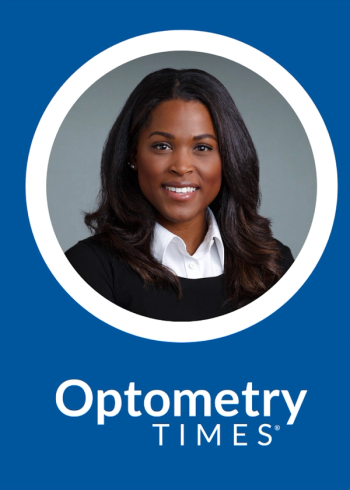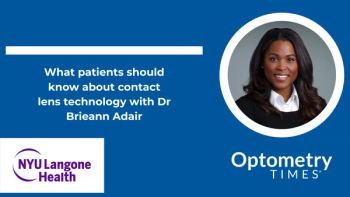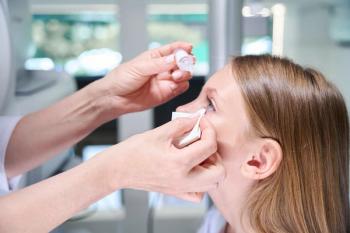
- February digital edition 2021
- Volume 13
- Issue 2
Soft toric lens fitting practices not meeting patient needs
Some markets—including US, Japan, Greece—see opportunities to fit more astigmatic patients
The inclusion of astigmatic correction in spectacles is common practice. Outside of the need to reduce a high or previously uncorrected astigmatism to ease adaption, eyecare professionals (ECPs) routinely prescribe the full toric correction in spectacles. Historically, the lack of availability of consistently performing, comfortable soft toric contact lens designs resulted in different prescribing practices for astigmats compared to those wearing spectacles, with spherical lenses often recommended over toric lenses for low to moderate levels of astigmatism.
Modern soft toric designs are significantly different from early non-planned replacement versions of 20 or more years ago. Their overall performance—which includes ease of fitting, comfort, rotational stability, vision performance, and consistent manufacturing in a range of designs and materials—enables them to be fit successfully to a wide range of astigmatic patients.
This review provides an overview of current soft toric prescribing, comparing and contrasting different fitting practices around the globe, and explores patient expectations and the opportunities that exist to meet their needs.
Prevalence of astigmatism
To analyze current soft toric fitting practice, first it is important to understand the prevalence of astigmatism in the general population. Once defined, it is possible to gain a measure of how proactive a particular country’s ECPs are on average with their routine recommendation of soft toric correction.
Estimates of astigmatism prevalence vary based on a number of factors. Defining it by the presence of any astigmatism (0.25 DC) will result in a higher number than using a minimum level of astigmatism of at least 0.75 DC. Given that ECPs typically consider 0.75 DC as the lowest amount considered to be in need of soft toric correction,1 this may be a more useful threshold. The use of data from only one eye compared to both eyes changes prevalence estimates, and given that astigmatism becomes more common with age,2,3 the range of ages included in the dataset has an influence, too. Variation in prevalence is also apparent depending on the study population with regional differences reported in a recent meta-analysis ranging from 11.4% (95% CI: 2.1- 20.7) in Africa to 45.6% (95% CI: 44.1- 47.1) in the Americas,4 and 44.8% (95% CI: 36.6 -53.1) in Southeast Asia.5
With these factors in mind, the global prevalence of astigmatism of at least 0.75 DC (described as >0.50 DC) is 40% (95% CI: 34-47) among those over age 30.5 Assuming the contact lens-wearing population is representative of the larger visually corrected population, if ECPs routinely recommended toric lenses to all astigmats of at least 0.75 DC, it would be expected that use of soft torics would represent a similar proportion of soft lens fits.
So, how do fitting practices compare?
Current toric fitting
While the prevalence of astigmatism has not changed significantly during the last three decades,5 soft toric lens design and availability certainly has. Given the wide choice of materials, replacement schedules, prescription options, and toric lens designs, the ECP has many options from which to choose.
Data from the 2020 international contact lens prescribing report show soft toric lenses represented 28% of all soft lens fits reported (average of 24 countries reporting more than 100 fits).6 Of these soft fits, the largest proportion came from spherical and toric lenses, respectively, with smaller contributions from multifocal, monovision, cosmetic, and myopia control fits. While the contribution from these smaller groups represents on average 20% of total soft lens fits,6 the nature of those categories suggests they would often involve spherical lenses (cosmetic, myopia control) rather than toric.
The data are shown in Figure 1, with the central purple bar showing the average rate of 28% of soft lens fits resulting from the use of toric lenses.6
Figure 1 shows broad differences in toric prescribing habits among countries. Use of soft torics ranges from 7% in Lithuania, 17% in Japan, through 43% in Italy and 47% in Sweden. A large contact lens market such as the United Kingdom records 30% of all soft fits as toric, noting whenother soft lens fits are removed toric fits represent 43% compared to 57% of spherical lens use. This difference reflects the broader use of other soft lenses, specifically multifocals and monovision for presbyopes. Note that the same comparison between toric and spherical does not show such a large change in US fitting practices. Toric lens fits represent 27% of all soft fits in the United States and 34% of fits when only compared to spherical lenses. This data indicates that the US market, along with other countries that also fall below the 40% figure—such as Japan (18%) and Greece (23%)—have an opportunity to be more proactive.
It is also relevant to note that the international contact lens prescribing report provides a snapshot of fitting activity for each year the survey is conducted. The number of ECPs returning completed surveys varies by country, and of course represents a very small proportion of the total number of ECPs in that region. Given the time required to complete the survey, it could be argued that those ECPs who do are a self-selecting group of interested contact lens practitioners to start with. Perhaps consider the results of the international contact lens prescribing report as a potential predictor of where the rest of that particular market may be heading over time.
Daily disposable torics
Fitting habits are influenced by lens availability, and increasingly, more soft toric options and expanded power ranges are available as daily disposables. Use of daily disposables as a modality is increasing worldwide, and while countries such as the United Kingdom and Denmark have reported significant fits with this modality for years,6 the United States has only more recently moved toward proactive fitting and refitting into daily disposables.
The global value of the spherical daily disposable market grew by 5% between 2018 and 2019, with the United States growing at 8% compared to 1% in the United Kingdom and 5% in Japan.7
Note the growth in the soft toric market over the same period. Globally, soft toric daily disposables grew nearly 3 times that of spherical lenses (14%), with double-digit growth in Japan (14%), the United Kingdom (13%), and the United States (19%).7 This indicates increased fitting of soft toric daily disposables and can be contrasted with global growth of frequently replaced soft torics at just 2% during the same period.7
These data show encouraging and growing use of soft toric daily disposables, suggesting—for these countries at least—the gap between astigmatism prevalence in the population and soft toric prescribing rate may close over time.
Eye care professional attitude
Interestingly, while the growth in soft toric lenses, and daily disposables torics in particular, is encouraging, it does not mean all ECPs trust the performance of these lenses. A recent survey of 400 ECPs in the United States sought to establish practitioners’ beliefs and attitudes toward soft toric contact lenses.8 Do they provide benefits for low astigmats over spherical contact lenses? Is vision with soft torics comparable to spectacles? Are they easy to fit?
The results were revealing. For visual performance, on average, 60% of responsdents agree that toric lenses provide better visual acuity for low astigmats (0.75 DC and 1.00 DC) than best-vision sphere contact lenses.8 This means 4 out of 10 ECPs may believe that a spherical correction in these patients is “good enough.” Further, only half agreed that they believed toric lenses provide the same visual acuity as a patient’s up-to-date spectacles.8
Together, these two results suggest 40% to 50% of ECPs believe spherical correction for low astigmats is fine and/or that toric contact lenses do not deliver visual acuity as good as spectacles. With this mindset, this subset of ECPs have compelling beliefs to avoid proactive toric recommendation.
Ideally, to be widely adopted, a contact lens should be quick and easy to fit with predictable performance. Nearly two-thirds (65%) of ECPs agreed toric lenses are quick to fit, although only around half agree they are as easy to fit as the equivalent spherical lens (49%) and that they have excellent rotational recovery (55%).8 This leaves one-third to one-half of ECPs potentially harboring concerns that soft torics are not easy to fit, take longer than spherical lenses, and may not have good rotational recovery.
Opportunities to explore
The wide variation in soft toric fitting practices around the world provides a number of areas to address. These include patient needs, professional communication, product performance, and practice set up. See Table 1 for a quick summary.
Correct low levels of astigmatism
This article opened by noting that low to moderate levels of astigmatism are rarely omitted from spectacle corrections. The impact of leaving as little as 1.00 DC of astigmatism uncorrected can result in a significant decrease in distance and near visual acuity, reading speed, with low levels (1.00 DC) of induced astigmatism also decreasing reading fluency, and stereoacuity.9-11 Uncorrected astigmatism can result in increased symptoms of ocular discomfort, dry eye and headaches.9,10 Contrary to historical thinking, spherical soft lenses, in particular thick or high-modulus designs, do not “mask” astigmatism.”12-15 Further, aspheric lenses do not demonstrate improved visual outcomes for low astigmats compared to toric corrections.16,17
Uncorrected astigmatism not only results in reduced performance and induced symptoms for the wearer but can ultimately lead to contact lens dropout. Sub-optimal vision performance is a significant cause of contact lens drop out by itself,18-20 with more recent research finding a correlation between worse vision and reduced overall comfort scores.21,22 Astigmats have been shown to over-index in contact lens dropouts,18,23 a fact which serves as a pertinent reminder to ensure the vision and comfort needs of this patient group are fully met in contact lenses.
When compared with spherical lenses, correction of astigmats with toric lens designs results in significantly improved subjective and objective visual performance.24,25 In practice, the benefit of fully correcting low amounts of astigmatism can be demonstrated with patients by having them view the smallest line of letters they can see both with and without the cylinder correction in place. These differences can be subtle and are often better demonstrated using a target that isn’t a letter chart.
Patient expectations
Patients want vision, comfort, and health from their contact lenses. Poor vision or comfort can result in dropout from lens wear. A prospective study of new wearer fits established dropout at 12 months to be 22.4%, with poor vision cited as the main cause of discontinuation (41%), followed by comfort (36%).20
Product performance and practice set up
Dissatisfaction with early hydrogel soft toric designs has been documented and includes reports of intolerance, inadequate fit, handling difficulties, and problems with vision.26 Unpredictable fitting characteristics,27 variable lens position with blinking,28 and head position29,30 all contribute to fluctuating vision and poor outcomes.
Given this history, it is understandable, as seen in the survey of U.S. practitioners, that some ECPs may still hold concerns about the performance of soft toric lenses.8 However, the design of modern toric lenses has evolved over time. A number of different approaches to achieving reliable and predictable orientation position and rotational stability exist, such as dual thin zones (Precision Curve lens design, Alcon) prism-ballast, modified or optimised prism-ballast (Optimised Toric Lens Geometry, CooperVision; Peri-ballast design, Bausch + Lomb), and dynamic stabilized designs (Blink Stabilized Design, Johnson & Johnson Vision).
The aim of these designs is to achieve both quick and consistent fitting for the ECP and deliver comfort and stable vision for the wearer. Several studies have examined the performance of modern soft toric lenses for static high contrast acuity, real-world visual tasks, rotational stability with eye and head movements, and rotational recovery. Results indicate, with small differences between designs, that modern methods of stabilization perform well.29-34
A study investigated the success of fitting astigmats with soft toric contact lenses in three patient groups: existing soft spherical lens wearers, contact lens dropouts, and neophytes.35 The fit success rate in order for those three groups was 80%, 75%, and 70%, respectively, with previous spherical lens wearers also recording an improvement in visual acuity, and the neophyte group a level of vision in their contacts lenses comparable to their spectacles. Results such as this are important to help dispel concerns still held by ECPs that soft toric lenses do not provide vision as good as spectacles.
ECPs tend to underestimate the proportion of patients that can be corrected with available soft toric contact lenses. In a recent survey in the United States, ECPs were asked, “What percentage of your astigmatic patients would you say you could prescribe with just that one [reusable] product?” Responses ranged from 55% to 74% depending on the product.8
When modern soft toric lens availability was compared to a large database of spectacle prescriptions, it was shown that typical coverage is higher than ECP beliefs; an example of which is a toric lens with cylinder correction available up to -1.75 DC, spherical powers from +4.00 D to -8.00 D, and 10 degree axes available around the clock provides cover for at least 90% of spectacle prescriptions,39 and that percentage may be even higher for some soft toric lenses.
Also, research shows that modern soft toric lenses are as quick to fit as spherical lenses.37 Plus, additional support and resources are available to ECPs and their staff to help achieve time-efficient fitting in practice. Access to trial sets in practice provides an opportunity to immediately offer toric contact lens experiences and deliver added value for the patient in one appointment.
Initial lens selection, either for trial sets or via pre-ordering, can be supported in a number of ways, ranging from manufacturer supplied fit guides, printed tools which confirm available prescription range, through to online toric lens calculators available, for example, from CooperVision, and Johnson & Johnson Vision. Accuracy of the online tool available from CooperVision, OptiExpert, has been shown to agree with investigator prescribed final prescriptions in 9 out of 10 eyes for different toric lenses.41,42 Use of this system supports accurate initial trial lens selection for CooperVision toric lenses, and also enables trained support staff to order trial lenses in ahead of scheduled-appointments, if trial lenses are not available. Both the accuracy of initial prescription choice, and the ability to use staff to order ahead, are helpful to ensure efficient use of time in practice. These approaches can be applied to other lens fittings, including spherical and multifocal.
Further opportunities
In those countries that already have a proportion of toric fits which approaches the prevalence of astigmatism in the general population, further opportunities exist.
Those patients with astigmatism in one eye only—monocular astigmats—should not be forgotten and may gain visual benefits from having their astigmatism fully corrected. Their visual need to wearing a single toric lens if the level of astigmatism in that eye is low (0.75 DC or 1.00 DC) may depend on whether the cylinder is in the dominant eye, the axis of their astigmatism, and the visual needs of the individual. The availability of several “families” of contact lenses enables patients to wear the same material in both eyes, one sphere and one toric design. Wide prescription availability across contact lens families results in the majority of patients being able to be fitted.36
Another group with the potential to be overlooked are those with low-moderate levels of astigmatism who wear lenses only part time. The potential attitude of “spherical is good enough” for part-time wear should be challenged, especially when the reasons for lens wear are factored in. That part-time wear may be for sports, hobbies requiring fine detailed vision, or social engagements where night driving may be necessary. Optimizing vision to be as good as spectacles could have significant benefits for these patients, and prescription range availability in daily disposable soft torics has increased over the last few years.
Remember also the low astigmats who are corrected with only spherical contact lenses. Although adapted to that level of acuity, they may benefit from improved quality of real-world vision if fully corrected. Additionally, quality of life scores have been shown to improve with a soft toric compared to a spherical lens for low to moderate astigmats.37
Conclusion
While some countries report relatively high levels of soft toric prescribing from a select group of ECPs in the international contact lens prescribing report, this may not be reflective of wider prescribing practices in the region, and wide variation still exists in how proactively soft torics are fit around the world. There are good reasons to check and ensure soft toric prescribing is not overlooked: patient’s visual demands are high, and sub-optimal vison performance leads to contact lens dropout. Modern soft toric contact lenses provide high first-fit success rates that can be made more time efficient in practice with the use of online fitting tools such as OptiExpert. Neophytes, lapsed wearers, low astigmats, monocular astigmats, and astigmatic presbyopes all present significant opportunities to recommend toric lenses and ensure the patient’s visual needs in their contact lenses are being met.
References
1. Young G, Sulley A, Hunt C. Prevalence of astigmatism in relation to soft contact lens fitting. Eye Contact Lens. 2011 Jan;37(1):20-5.
2. Sawada A, Tomidokoro A, Araie M, Yamamoto T, Tajimi Study Group. Refractive errors in an elderly Japanese population: the Tajimi study. Ophthalmology. 2008 Feb;115(2):363-70 e3.
3. Gudmundsdottir E, Jonasson F, Jonsson V, Stefánsson E, Sasaki H, Sasaki K. “With the rule: astigmatism is not the rule in the elderly. Reykjavik Eye Study: a population based study of refraction andvisual acuity in citizens of Reykjavik 50 years and older. Iceland- Japan Co-Working Study Groups. Acta Ophthalmol Scand. 2000 Dec;78(6):642-6.
4. Varma R, Torres M, McKean-Cowdin R, Rong F, Hsu C, Jiang X, Chinese American Eye Study Group. Prevalence and Risk Factors for Refractive Error in Adult Chinese Americans: The Chinese American Eye Study. Am J Ophthalmol. 2017 Mar;175:201-12.
5. Hashemi H, Fotouhi A, Yekta A, Pakzad R, Ostadimoghaddam H, Khabazkhoob M. Global and regional estimates of prevalence of refractive errors: Systematic review and meta-analysis. J Curr Ophthalmol. 2017 Sep 27;30(1):3-22.
6. Morgan P, Woods C, Tranoudis IG, et al. International Contact Lens Prescribing in 2019. Cont Lens Spectrum. Available at: https:// www.clspectrum.com/issues/2020/january-2020/international-contact-lens-prescribing-in-2019. Accessed 1/31/21.
8. CooperVision. Beyond vision correction: the real impact of contact lens wear on patients. Available at: https://coopervision.com/ sites/coopervision.com/files/cv_confclaims_report.pdf. Accessed 1/31/21.
9. Wolffsohn JS, Bhogal G, Shah S. Effect of uncorrected astigmatism on vision. J Cataract Refract Surg. 2011 Mar;37(3):454- 60.
10. Wills J, Gillett R, Eastwell E, Abraham R, Coffey K, Webber A, Wood J. Effect of simulated astigmatic refractive error on reading performance in the young. Optom Vis Sci. 2012 Mar;89(3):271-6.
11. Al-Qahtani H, Al-Debasi H. The effects of experimentally induced graded monocular and binocular astigmatism on near stereoacuity. Saudi J Ophthalmol. 2018 Oct-Dec;32(4):275-9.
12. Bernstein P, Gundel RE, Rosen JS. Masking corneal toricity with hydrogels: does it work? Int Contact Lens Clin. 1991 Mar- Apr;18(3):67-70.
13. Snyder C, Talley DK. Masking of astigmatism with selected spherical soft contact lenses. J Am Optom Assoc. 1989 Oct;60(10):728-31.
14. Edmonson LL, Edmondson W, Price R. Masking astigmatism CIBA Focus Night & Day vs Focus Monthly. Optom Vis Sci. 2003;80:184.
15. Cho P, Woo GC. Vision of low astigmats through thick and thin lathe-cut soft contact lenses. Cont Lens Anterior Eye. 2001;24(4):153-60.
16. Kollbaum PS, Bradley A. Aspheric contact lenses: Fact and fiction. Cont Lens Spectrum. Available at: https://www.clspectrum. com/issues/2005/march-2005/aspheric-contact-lenses-fact-and-fiction. Accessed 1/18/21.
17. Morgan PB, Efron SE, Efron N, Hill EA. Inefficacy of aspheric soft contact lenses for the correction of low levels of astigmatism. Optom Vis Sci. 2005 Sep;82(9):823-8.
18. Young G. Why one million contact lens wearers dropped out. Cont Lens Anterior Eye. 2004 Jun;27(2):83-5.
19. Sulley A, Young G, Hunt C. Factors in the success of new contact lens wearers. Cont Lens Anterior Eye. 2017 Feb;40(1):15-24.
20. Sulley A, Young G, Hunt C, McCready S, Targett MT, Craven R. Retention Rates in New Contact Lens Wearers. Eye Contact Lens. 2018 Sep;44Suppl 1:S273-S282.
21. Rao SBS, Simpson TL. Influence of Vision on Ocular Comfort Ratings. Optom Vis Sci. 2016 Aug;93(8):793-800.
22. Maldonado-Codina C, Navascues Cornago M, Read ML, et al. The association of comfort and vision in soft toric contact lens wear. Cont Lens Anterior Eye. 2020. doi: 10.1016/j.clae.2020.11.007.
23. Young G, Veys J, Pritchard N, Coleman S. A multi-centre study of lapsed contact lens wearers. Ophthalmic Physiol Opt. 2002 Nov;22(6):516-27.
24. Cho P, Cheung SW, Charm J. Visual outcome of Soflens Daily Disposable and Soflens Daily Disposable for Astigmatism in subjects with low astigmatism. Clin Exp Optom. 2012 Jan;95(1):43- 7.
25. Kruse A, Løfstrøm T. How much visual benefit does an astigmat achieve being corrected with a toric correction? Int Contact Lens Clin. 1996 Mar-Apr;23(2):59-65.
26. Evans J, Hau S. The therapeutic and optical application of a rigid gas permeable semi-limbal diameter contact lens. Cont Lens Anterior Eye. 2009 Aug;32(4):165-9.
27. Tan J, Papas E, Carnt N, Jalbert I, Skotnisky C, Shiobara M, Lum E, Holden B. Performance standards for toric soft contact lenses. Optom Vis Sci. 2007 May;84(5):422-8.
28. Tomlinson A, Ridder W, Watanabe R. Blink-induced variations in visual performance with toric soft contact lenses. Optom Vis Sci. 1994 Sep;71(9):545-9.
29. Young G, McIlraith R, Hunt C. Clinical evaluation of factors affecting soft toric lens orientation. Optom Vis Sci. 2009 Nov;86(11):E1259-66.
30. McIlraith R, Young G, Hunt C. Toric lens orientation and visual acuity in non-standard conditions. Cont Lens Anterior Eye. 2010 Feb;33(1):23-6; quiz 43-4.
31. Momeni-Moghaddam H, Naroo SA, Askarizadeh F, Tahmasebi F. Comparison of fitting stability of the different soft toric contact lenses. Cont Lens Anterior Eye. 2014 Oct;37(5):346-50.
32. Edrington TB. A literature review: the impact of rotational stabilization methods on toric soft contact lens performance. Cont Lens Anterior Eye. 2011 Jun;34(3):104-10.
32. Zikos GA, Kang SS, Ciuffreda KJ, Selenow A, Ali S, Spencer LW, Robilotto R, Lee M. Rotational stability of toric soft contact lenses during natural viewing conditions. Optom Vis Sci. 2007 Nov;84(11):1039-45.
34. Chamberlain P, Morgan PB, Moody KJ, Codina-Maldonado C. Fluctuation in visual acuity during soft toric contact lens wear. Optom Vis Sci. 2011Apr;88(4):E534-8.
35. Sulley A, Young G, Lorenz KO, Hunt C. Clinical evaluation of fitting toric soft contact lenses to current non-users. Ophthalmic Physiol Opt. 2013 Mar;33(22):94-103.
36. Luensmann D, Schaeffer JL, Rumney NJ, Stanberry A, Walsh W, Jones L. Spectacle prescriptions review to determine prevalence of ametropia and coverage of frequent replacement soft toric contact lenses. Cont Lens Anterior Eye. 2018 Oct;41(5):412-420.
37. Cox SM, Berntsen DA, Bickle KM, Mathew JH, Powell DR, Little BK, Lorenz KO, Nichols JJ. Efficacy of Toric Contact Lenses in Fitting and Patient-Reported Outcomes in Contact Lens Wearers. Eye Contact Lens. 2018 Sep;44 Suppl 1:S296-S9.
Articles in this issue
almost 5 years ago
Quiz: Patient experiences sudden decrease in visionalmost 5 years ago
Review Duane’s retraction syndrome diagnosis and treatmentalmost 5 years ago
Point-of-care testing helps dry eye diagnosisalmost 5 years ago
Patient experiences sudden decrease in visionalmost 5 years ago
How to improve telehealthalmost 5 years ago
High IOP, uveitis lead to Posner-Schlossman diagnosisalmost 5 years ago
Differential key to diagnosing idiopathic orbital inflammationalmost 5 years ago
How to avoid patient nonadherenceNewsletter
Want more insights like this? Subscribe to Optometry Times and get clinical pearls and practice tips delivered straight to your inbox.













































